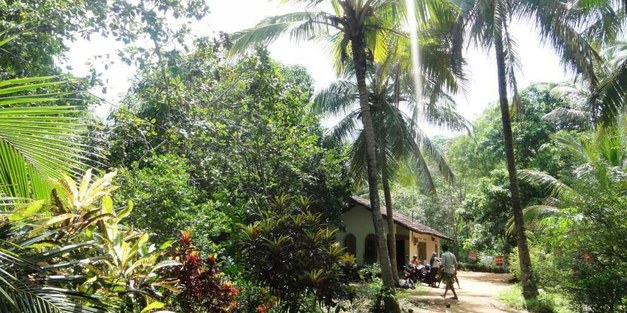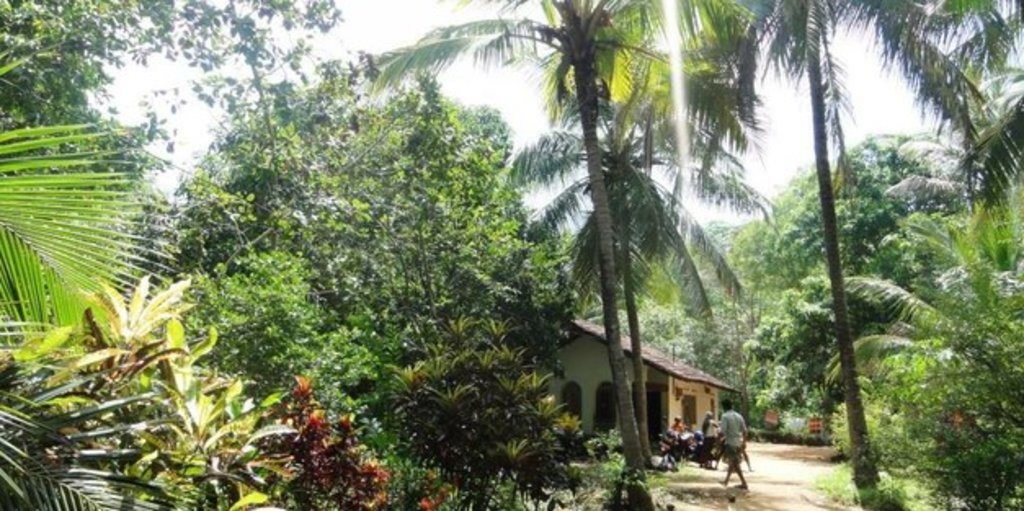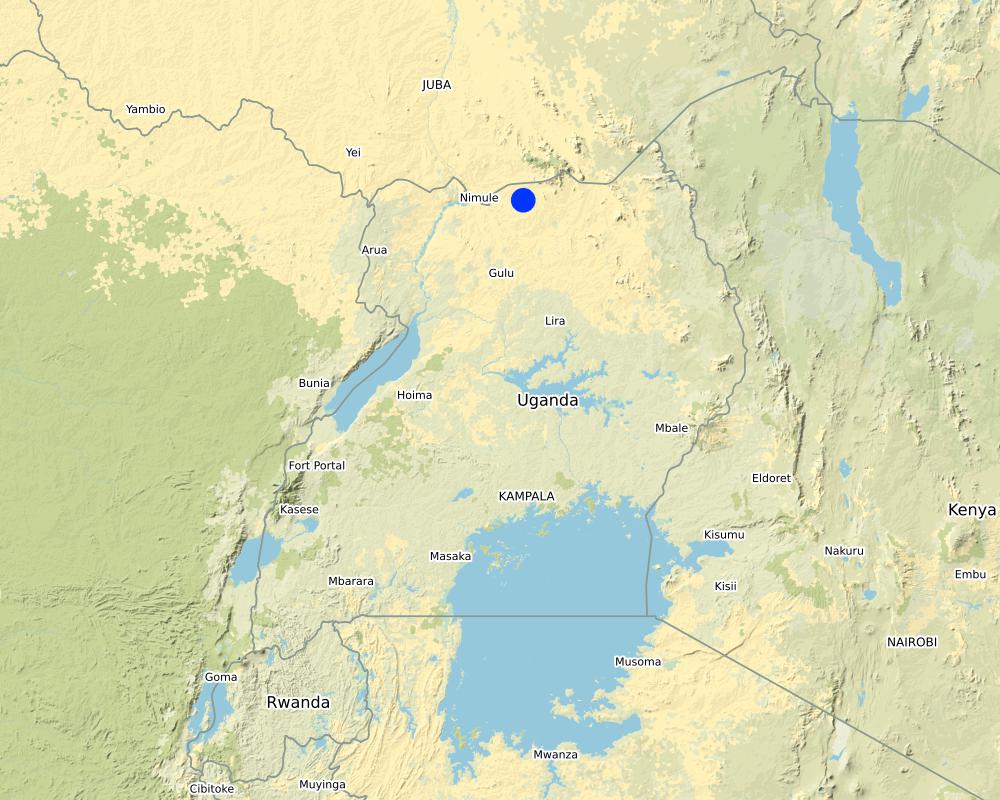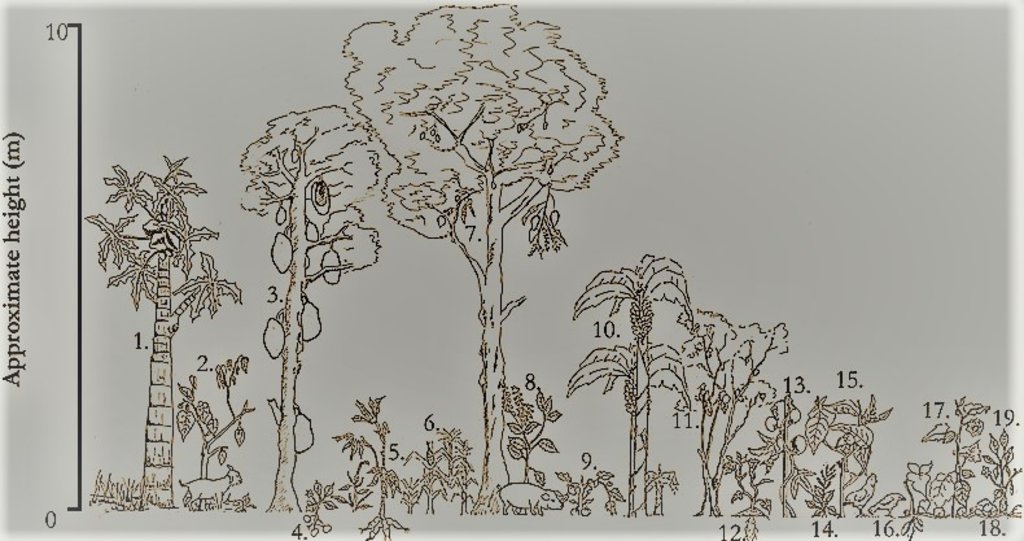Home Gardens [乌干达]
- 创建:
- 更新:
- 编制者: Bernard Fungo
- 编辑者: JOY TUKAHIRWA, Kamugisha Rick Nelson, betty adoch, Sunday Balla Amale
- 审查者: Nicole Harari, Stephanie Jaquet, Udo Höggel
Yen apita gang ki nyig yat
technologies_2881 - 乌干达
查看章节
全部展开 全部收起1. 一般信息
1.2 参与该技术评估和文件编制的资源人员和机构的联系方式
有助于对技术进行记录/评估的项目名称(如相关)
Scaling-up SLM practices by smallholder farmers (IFAD)有助于对技术进行记录/评估的机构名称(如相关)
Uganda Landcare Network (ULN) - 乌干达1.3 关于使用通过WOCAT记录的数据的条件
(现场)数据是什么时候汇编的?:
13/4/2017
编制者和关键资源人员接受有关使用通过WOCAT记录数据的条件。:
是
1.4 所述技术的可持续性声明
这里所描述的技术在土地退化方面是否存在问题,导致无法被认为是一种可持续的土地管理技术?:
否
2. SLM技术的说明
2.1 技术简介
技术定义:
Home gardens provide low-income households with continuous food supply and increase the resilience of their livelihoods to climate change
2.2 技术的详细说明
说明:
Home gardens are area where the cultivation of a small portion of land, usually around a homestead or within walking distance from the family home. Usually, a mixture of several crops that may include vegetables, fruits, plantation crops, spices, herbs, ornamental and medicinal plants as well as livestock that can serve as a supplementary source of food and income. Home gardens are a cropping system composed of soil, crops, weeds, pathogens and insects that convert resource inputs - solar energy, water, nutrients, labor, etc. - into food, feed, fuel, fiber and pharmaceuticals. Home gardens are important ways to ensure that the low-income households have access to the all the basic livelihood needs throughout the year. This is a resilience technology for resource-constrained farmers in remote parts of the world. During the wet season, farmers plant additional crops mainly vegetables to utilize the lower-storey niches because such crops are more shade tolerant. The multi-species and multi-canopy structure of the farming systems ensures stability against climate extremes such as drought, strong winds and dry spells.
The main features that characterize a home garden are (1) located near the residence; (2) containing a high diversity of plants; (3) production is supplemental rather than a main source of family consumption and income; (4) occupying a small area (~3 acres) and (5) requiring very low external inputs, relying mainly on recycling of crop residues and cow dung and seed from previous season’s harvest.
Home gardens play the role of producing subsistence items and generating additional income for the household. They are known for their stable yields, very varied products, continuous or repeated harvests during the year and low inputs. Whereas home gardens may not be the major sources of livelihood, they are known to contribute 10-35 percent of livelihoods of farmers and their productivity is reported to be up to 20 times that of other land uses such as irrigated fields, rise fields and fish ponds. home gardens are also an important source of nutrients providing approximately 10, 12, 150, 16, 31, 25 and 113 percent of the minimum daily requirement of protein, calcium, carotene, thiamine, riboflavin, niacin and ascorbic acid, respectively.
A large proportion of the products of home gardens is consumed by farmer families especially due to the remoteness of the area where a market economy has not yet developed. Home gardens also play sociol-cultural functions and provide products for religious rituals and ceremonies. The aesthetic role of home gardens is also considered important especially during the dry season when people spend evenings out in the garden. Hence, paying attention solely to the tangible economic and nutritional gains of home gardens, and agroforestry in general misses the various intangible ecological and social values.
2.3 技术照片
2.4 技术视频
日期:
13/2017
位置:
Lamwo District , Northern Uganda
摄影师的名字:
Issa Aliga
2.5 已应用该技术的、本评估所涵盖的国家/地区/地点
国家:
乌干达
区域/州/省:
Lamwo District, Northern Uganda
注释:
Coordinates of only one location are indicated but there were several sites with home gardens.
Map
×2.6 实施日期
注明实施年份:
2008
2.7 技术介绍
详细说明该技术是如何引入的:
- 作为传统系统的一部分(> 50 年)
3. SLM技术的分类
3.1 该技术的主要目的
- 改良生产
- 保护生态系统
- 降低灾害风险
- 适应气候变化/极端天气及其影响
- 创造有益的经济影响
- 创造有益的社会影响
3.2 应用该技术的当前土地利用类型

混合(作物/放牧/树木),包括农林
- 农林业
- 农牧业
- 农林牧业
- 林牧业
注释:
All elements of agroforoestry are present in the home gardens
3.3 有关土地利用的更多信息
该技术所应用土地的供水:
- 雨养
每年的生长季节数:
- 2
具体说明:
March to May and September to November
3.4 该技术所属的SLM组
- 农业林学
- 家庭花园
3.5 技术传播
具体说明该技术的分布:
- 均匀地分布在一个区域
如果该技术均匀地分布在一个区域上,请注明覆盖的大致区域。:
- < 0.1 平方千米(10 公顷)
注释:
Home gardens are usually smaller than 3 acres
3.6 包含该技术的可持续土地管理措施

农艺措施
- A1:植被和土壤覆盖层

植物措施
- V1:乔木和灌木覆盖层

结构措施
- S9:动植物庇护所

管理措施
- M5:物种组成的控制/变化
3.7 该技术强调的主要土地退化类型

生物性退化
- Bc:植被覆盖的减少
- Bh:栖息地丧失
3.8 防止、减少或恢复土地退化
具体数量名该技术与土地退化有关的目标:
- 防止土地退化
- 适应土地退化
4. 技术规范、实施活动、投入和成本
4.1 该技术的技术图纸
作者:
Adapted from (Whitney et al. 2017) Artwork by Carolyne Nakaketo.
日期:
13/4/2017
4.2 技术规范/技术图纸说明
A typical multilayered Ugandan homegarden structure showing approximate heights for a diversity of edible species. Plants numbered: 1. Carica papaya, 2. Solanum betaceum, 3. Artocarpus heterophyllus, 4. Solanum tuberosum, 5. Manihot esculenta, 6. Zea mays, 7. Mangifera indica, 8. Ocimum gratissimum, 9. Solanum lycopersicum, 10. Musa spp., 11. Psidium guajava, 12. Ipomoea batatas, 13. Passiflora spp., 14. Amarathus spp., 15. Solanum aethiopicum, 16. Xanthasoma spp., 17. Physalis peruviana, 18. Cucurbita spp., and 19. Capsicum spp.
- Land area is approximately 3 acres
-The mixture of plant species benefits form the various niches within the canopy
-Taller, light demanders occupy the upper canopy while the shorter shade tolerant ones occupy the lower canopy
- The homestead is within few meters (< 50 m) of the crop and livestock setting
- Livestock shelter usually located under trees to protect them from hot sunshine
- Kitchen residues are spread in the nearby are, providing fertility to the crops therein. Therefore, the plants nearer the house are generally more healthy
- The home garden is more or less a closed system with limited external input or export of resources to outside
4.3 有关投入和成本计算的一般信息
具体说明成本和投入是如何计算的:
- 每个技术单元
指定单位:
Acres
指定体积、长度等(如果相关):
3
其它/国家货币(具体说明):
Uganda Shillings
注明美元与当地货币的汇率(如相关):1美元=:
3500.0
注明雇用劳工的每日平均工资成本:
5000
4.4 技术建立活动
| 活动 | 措施类型 | 时间 | |
|---|---|---|---|
| 1. | Planting | 农业学的 | Start of wet season |
| 2. | Weeding | 管理 | Throughout the year |
| 3. | Manure management | 管理 | Throughout the year |
| 4. | Pruning | 农业学的 | Throughout the year |
4.5 技术建立所需要的费用和投入
| 对投入进行具体说明 | 单位 | 数量 | 单位成本 | 每项投入的总成本 | 土地使用者承担的成本% | |
|---|---|---|---|---|---|---|
| 劳动力 | Planting | Days | 20.0 | 5000.0 | 100000.0 | 100.0 |
| 劳动力 | Weeding | Days | 20.0 | 5000.0 | 100000.0 | 100.0 |
| 劳动力 | Manure Management | Days | 20.0 | 5000.0 | 100000.0 | 100.0 |
| 劳动力 | Pruning | Days | 20.0 | 5000.0 | 100000.0 | 100.0 |
| 植物材料 | Seeds | kg | 5.0 | 50000.0 | 250000.0 | 100.0 |
| 植物材料 | Suckers and stem cuttings | pieces | 200.0 | 500.0 | 100000.0 | 100.0 |
| 肥料和杀菌剂 | Animal manure | kg | 2000.0 | 2000.0 | 4000000.0 | 100.0 |
| 施工材料 | Poles | Pieces | 100.0 | 5000.0 | 500000.0 | 100.0 |
| 施工材料 | Nails | kg | 15.0 | 3000.0 | 45000.0 | 100.0 |
| 技术建立所需总成本 | 5295000.0 | |||||
4.6 维护/经常性活动
| 活动 | 措施类型 | 时间/频率 | |
|---|---|---|---|
| 1. | Planting | 农业学的 | Once a year |
| 2. | Weedindg | 管理 | Twice a year |
| 3. | Prunning | 管理 | Three times a year |
| 4. | Manure manageemnt | 管理 | Throughout the year |
4.7 维护/经常性活动所需要的费用和投入(每年)
如果可能,按下表分解技术维护费用,并列明各项投入和每项投入的费用。如果您无法分解成本,给出维护该技术的总成本估算。:
300000.0
| 对投入进行具体说明 | 单位 | 数量 | 单位成本 | 每项投入的总成本 | 土地使用者承担的成本% | |
|---|---|---|---|---|---|---|
| 劳动力 | Planting | Days | 20.0 | 5000.0 | 100000.0 | 100.0 |
| 劳动力 | Weeding | Days | 20.0 | 5000.0 | 100000.0 | 100.0 |
| 劳动力 | Manure management | Days | 20.0 | 5000.0 | 100000.0 | 100.0 |
| 劳动力 | Pruning | Days | 20.0 | 5000.0 | 100000.0 | 100.0 |
| 设备 | 3.0 | |||||
| 植物材料 | Seeds | kg | 2.0 | 30000.0 | 60000.0 | 100.0 |
| 植物材料 | Suckers and stem cuttings | Pieces | 50.0 | 500.0 | 25000.0 | 100.0 |
| 肥料和杀菌剂 | Manure | kg | 2000.0 | 2000.0 | 4000000.0 | 100.0 |
| 施工材料 | Poles | Pieces | 30.0 | 5000.0 | 150000.0 | 100.0 |
| 施工材料 | Nails | kg | 5.0 | 5000.0 | 25000.0 | 100.0 |
| 技术维护所需总成本 | 4660000.0 | |||||
4.8 影响成本的最重要因素
描述影响成本的最决定性因素:
Labour for maintaining the garden, especially pruning
5. 自然和人文环境
5.1 气候
年降雨量
- < 250毫米
- 251-500毫米
- 501-750毫米
- 751-1,000毫米
- 1,001-1,500毫米
- 1,501-2,000毫米
- 2,001-3,000毫米
- 3,001-4,000毫米
- > 4,000毫米
农业气候带
- 半湿润
5.2 地形
平均坡度:
- 水平(0-2%)
- 缓降(3-5%)
- 平缓(6-10%)
- 滚坡(11-15%)
- 崎岖(16-30%)
- 陡峭(31-60%)
- 非常陡峭(>60%)
地形:
- 高原/平原
- 山脊
- 山坡
- 山地斜坡
- 麓坡
- 谷底
垂直分布带:
- 0-100 m a.s.l.
- 101-500 m a.s.l.
- 501-1,000 m a.s.l.
- 1,001-1,500 m a.s.l.
- 1,501-2,000 m a.s.l.
- 2,001-2,500 m a.s.l.
- 2,501-3,000 m a.s.l.
- 3,001-4,000 m a.s.l.
- > 4,000 m a.s.l.
说明该技术是否专门应用于:
- 不相关
5.3 土壤
平均土层深度:
- 非常浅(0-20厘米)
- 浅(21-50厘米)
- 中等深度(51-80厘米)
- 深(81-120厘米)
- 非常深(> 120厘米)
土壤质地(表土):
- 粗粒/轻(砂质)
土壤质地(地表以下> 20厘米):
- 粗粒/轻(砂质)
表土有机质:
- 中(1-3%)
5.4 水资源可用性和质量
地下水位表:
5-50米
地表水的可用性:
中等
水质(未处理):
不良饮用水(需要处理)
水的盐度有问题吗?:
否
该区域正在发生洪水吗?:
否
5.5 生物多样性
物种多样性:
- 中等
栖息地多样性:
- 中等
5.6 应用该技术的土地使用者的特征
定栖或游牧:
- 定栖的
生产系统的市场定位:
- 生计(自给)
非农收入:
- 收入的10-50%
相对财富水平:
- 贫瘠
个人或集体:
- 个人/家庭
机械化水平:
- 手工作业
性别:
- 女人
- 男人
土地使用者的年龄:
- 中年人
- 老年人
5.7 应用该技术的土地使用者拥有或租用的平均土地面积
- < 0.5 公顷
- 0.5-1 公顷
- 1-2 公顷
- 2-5公顷
- 5-15公顷
- 15-50公顷
- 50-100公顷
- 100-500公顷
- 500-1,000公顷
- 1,000-10,000公顷
- > 10,000公顷
这被认为是小规模、中规模还是大规模的(参照当地实际情况)?:
- 小规模的
5.8 土地所有权、土地使用权和水使用权
土地所有权:
- 个人,未命名
土地使用权:
- 个人
用水权:
- 个人
5.9 进入服务和基础设施的通道
健康:
- 贫瘠
- 适度的
- 好
教育:
- 贫瘠
- 适度的
- 好
技术援助:
- 贫瘠
- 适度的
- 好
就业(例如非农):
- 贫瘠
- 适度的
- 好
市场:
- 贫瘠
- 适度的
- 好
能源:
- 贫瘠
- 适度的
- 好
道路和交通:
- 贫瘠
- 适度的
- 好
饮用水和卫生设施:
- 贫瘠
- 适度的
- 好
金融服务:
- 贫瘠
- 适度的
- 好
6. 影响和结论性说明
6.1 该技术的现场影响
社会经济效应
生产
作物生产
注释/具体说明:
Better yields due to manure application from kitchen residues, soil erosion control and litter decomposition
木材生产
注释/具体说明:
Wood from pruning are used for cooking, reducing the need to walk long distances
产品多样性
注释/具体说明:
Many crops and livestock products from the mixture of enterprises on the land
收入和成本
农业投入费用
注释/具体说明:
Most of the inputs e.g. seeds and manure come from with the farm, therefore low cost of inputs
农业收入
工作量
注释/具体说明:
So many small activities requiring labour all the time makes the workload big for the land manager
生态影响
土壤
土壤覆盖层
注释/具体说明:
Continuous soil cover due to perennials such as trees
土壤有机物/地下C
注释/具体说明:
Litter fall and decomposition increases soil organic matter
6.2 该技术的场外影响已经显现
下游淤积
注释/具体说明:
Reduced runoff and erosion due to continuous soil cover
6.3 技术对渐变气候以及与气候相关的极端情况/灾害的暴露和敏感性(土地使用者认为的极端情况/灾害)
气候有关的极端情况(灾害)
气候灾害
| 该技术是如何应对的? | |
|---|---|
| 干旱 | 好 |
生物灾害
| 该技术是如何应对的? | |
|---|---|
| 昆虫/蠕虫侵扰 | 好 |
6.4 成本效益分析
技术收益与技术建立成本相比如何(从土地使用者的角度看)?
短期回报:
积极
长期回报:
非常积极
技术收益与技术维护成本/经常性成本相比如何(从土地使用者的角度看)?
短期回报:
积极
长期回报:
积极
6.5 技术采用
- 10-50%
在所有采用这项技术的人当中,有多少人是自发地采用该技术,即未获得任何物质奖励/付款?:
- 0-10%
6.6 适应
最近是否对该技术进行了修改以适应不断变化的条件?:
否
6.7 该技术的优点/长处/机会
| 土地使用者眼中的长处/优势/机会 |
|---|
| Continuous supply for farm produce through out the year |
| Relatively easy access to planting materials since they are all obtained from within the home garden |
| 编制者或其他关键资源人员认为的长处/优势/机会 |
|---|
| Diversity of the home garden implies resilience to extreme weather events like drought and dry spells |
| Home gardens provide a variety of products that diversify the diet of the participating household and therefore, improve nutrition security |
6.8 技术的弱点/缺点/风险及其克服方法
| 土地使用者认为的弱点/缺点/风险 | 如何克服它们? |
|---|---|
| Labour intensive and takes place through out the year | |
| Low amounts of produce per crop is inadequate to meet family needs | A portion of the home garden production needs to be commercialised so to generate income for the family |
| 编制者或其他关键资源人员认为的弱点/缺点/风险 | 如何克服它们? |
|---|---|
| Dependence on traditional practices develop a negative nutrient balance of the farming system | Include some fertilizer and pesticides to improve the nutrient balance |
| Failure to adequately prune heavy branches on large upper-storey trees can cause significant yield loss to under-storey species | Constant pruning to open up the canopy for sufficient light to flow into reach the lower canopy species |
7. 参考和链接
7.1 信息的方法/来源
- 实地考察、实地调查
1
- 与土地使用者的访谈
1
7.3 链接到网络上可用的相关信息
标题/说明:
Plants in the Homegardens in Uganda
URL:
https://www.researchgate.net/publication/325459387_Ethnobotany_and_Agrobiodiversity_Valuation_of_Plants_in_the_Homegardens_of_Southwestern_Uganda
链接和模块
全部展开 全部收起链接
无链接
模块
无模块






